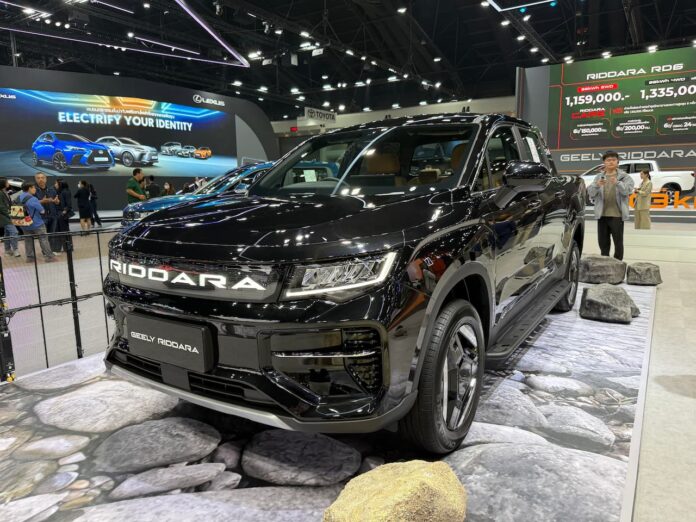Geely Holding Group, which owns Volvo, Polestar, Lotus, Zeekr, etc, introduced a new sub-brand in China on July 12, 2022, called Radar Auto. At the same event, the Radar RD6 pickup truck made its official debut. Since then, Geely has introduced the electric truck in over 50 markets across Eastern Europe, Asia, the Middle East and Latin America, under the ‘Riddara’ brand.
I spent some time with the RD6 pickup truck at the Bangkok International Motor Show 2025, trying to understand if Volvo could see an opportunity rebadging the truck, and here’s what I found.
The RD6 has a clean, modern look with subtle styling. At the front, a clamshell hood carries the bold ‘Riddara’ badge, and an LED light bar stretches across the width. A closed grille sits between sharp full-LED headlights. The bumper features large intake housings and a faux skid plate below.
From the side, the RD6 looks sharp with sculpted fenders, chunky mirrors, and a mix of chrome and matte black trim. The 17-inch wheels seem small for its adventure-focused image. At the back, X-shaped LED tail lights add character to the clean design.
After spending some time closely examining its exterior, three features really stood out to me: the bold illuminated brand inscription, the high-quality chrome window surround, and the connected tail lamps.
The RD6’s cabin feels modern and well-finished. It features a 14.6-inch touchscreen with Apple CarPlay and Carbit Link, a 50W wireless phone charger, dual-zone climate control with rear vents, and a CN95 PM2.5 air filter.
The front leather seats that are ventilated, power-adjustable in six ways, and recline 180 degrees. Safety features include up to 14 ADAS functions, a surround view camera, six airbags, and a body structure made of over 70% high-strength steel.
I’m 5 ft 7 in, and given the height of the RD6, which is comparable to a Jeep Wrangler, I found ingress and egress effortless.
When I sat in the driver’s seat, I immediately noticed that all-around visibility was superb. The steering wheel, with a manually adjustable column, had a thick rim and felt grippy. My head was comfortably lower than the headliner. The lumbar support felt good, while under-thigh support was decent but might not be enough for someone 6 feet or taller.
The overall quality of materials was surprisingly great with plenty of soft-touch surfaces and fine plastics throughout the cabin. During my time with the truck, I especially liked the touch and tactility of the switches, the green-colored padding, and the copper-colored cross-stitching on the dashboard, door panels, and center console.
The gauge cluster had crisp picture quality and sharp graphics. There was an interesting knurled dial below the right-most AC vent for adjusting brightness. The infotainment screen was easy to use, and there was a separate climate control panel below it, which is a practical design.
In the second row, sitting behind the driver’s seat adjusted for a 5’7-tall person, I had plenty of legroom and knee room. The default angle of the backrest felt quite comfortable. A recline function wasn’t available.
Under-thigh support was okay, and I felt that the cushion could’ve been a little longer. Here I had more than four inches of headroom. Rear seat passengers get a center armrest with two cupholders, two AC vents, and outer-position ventilation, all of which I found useful.
The RD6 measures 207 in. long, 74.8 in. wide, and 73.4 in. tall. The pickup truck has a wheelbase of 122.8 in., while its minimum turning radius is 6.1 meters or 20 feet. As for the bed, it’s 60 in. long, 57 in. wide, and 21.2 in. high. The payload capacity of the truck is 2,270.7 lbs, the towing capacity is 6,613.8 lbs., while the front trunk (frunk) brings in an additional 70 liters or 2.4 cubic feet.
The RD6 pickup is built on Geely’s pure electric platform and technical architecture, better known as the Sustainable Experience Architecture or SEA. The electric pickup truck is equipped with McPherson independent suspension at the front and a multi-link independent setup at the back, with four disc brakes.
The top-spec RD6 is powered by a permanent magnet synchronous motor on each axle, producing 315 kW (422 hp) of maximum power and 595 Nm (439 lb-ft) of torque. The dual-motor powertrain uses an 86 kWh NMC battery, offering a driving range of up to 455 km (283 miles, NEDC) and a top speed of 190 km/h (118 mph). For charging, the truck supports DC fast charging from 30% to 80% in 32 minutes at 100 kW, and AC charging from 20% to 100% in 11 hours using a 220V/240V outlet at 6.6 kW.
In Thailand, the RD6 starts at 899,000 baht (approx. USD 26,970) for the 2WD version with a 63 kWh battery. The top-spec 4WD model with an 86 kWh battery is priced at 1,299,000 baht (approx. USD 38,970).
Don’t mistake us, the RD6 is stylish and capable, and is well positioned to be the first all-electric truck for many buyers in emerging markets. However, it doesn’t align with Volvo’s brand attributes, which focus on Scandinavian design and premium comfort.
The RD6 targets the mass-market segment with a tempting package. That’s not a space Volvo aims to compete in, especially after the Mercedes X-Class experiment, where the upmarket cousin of the Nissan Navara failed to meet premium expectations.
Finally, customer needs vary across Europe, North America, and Asia, when it comes to the type of electrification and powertrain preferences. Instead of restyling an existing product, we feel that Volvo would be better off developing a dedicated truck to fulfill its brand promise, if it ever decides to enter this segment.


